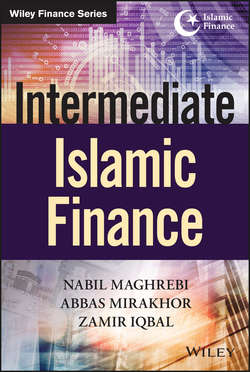Intermediate Islamic Finance

Реклама. ООО «ЛитРес», ИНН: 7719571260.
Оглавление
Mirakhor Abbas. Intermediate Islamic Finance
Preface
About the Authors
Chapter 1. Epistemology of Finance
Epistemology of an Ideal Conventional Financial System
Epistemology of an Ideal Islamic Financial System
Risk-Sharing Finance in a World of Uncertainty
Summary and Conclusions
Chapter 2. Finance and Ethics
Renewed Interest in Ethical Finance
Embedded Ethical Issues in Financial Theory
Cases of Ethical Issues in Finance
Virtue Ethics Model
Islamic Framework of Business Ethics
Summary and Conclusions
Chapter 3. The Analytics of Finance
The Theory of Interest
The Concept of Time Value
Utility Theory, Risk Aversion, and Risk Premium
The Individual's Optimal Consumption and Portfolio Choices
Market Efficiency and the Random-Walk Hypothesis
Risk Sharing in Finance
Summary and Conclusions
Chapter 4. Equity, Efficiency, and Firm Behavior
Methodological Issues in Islamic economics
Theories of Firm Behavior in Islamic Economics
The Profit-Sharing Principle
A Theoretical Construct of Equity and Allocative Efficiency
Summary and Conclusions
Chapter 5. Asset Pricing and Corporate Finance
Capital Asset Pricing Model
Arbitrage Pricing Theory
Capital Structure Theory
Summary and Conclusions
Chapter 6. Scope of Financial Engineering and Derivatives
Risk Hedging with Forward and Futures Contracts
Properties of Options Contracts
Option Valuation Theory
Applications of Option Pricing Theory in Islamic Finance
Risk Hedging and the Scope of Financial Engineering in Islamic Finance
Summary and Conclusions
Chapter 7. Financing Models and Ownership Transfer
Structure and Dynamics of Outstanding Balances
Ownership Transfer
Hybrid Financing Models Based on Risk Sharing
Summary and Conclusions
Chapter 8. Securitization and Structured Finance
Risk Transfer with Credit-Default Swaps
The Mechanics of Securitization and Structured Finance
Complexity of Contract Structures
Securitization, Structured Finance, and Completeness of Contracts
Securitization, Risk Transfer with Wa'ad Structures, and Options Strategies
Summary and Conclusions
Chapter 9. Financial Stability
The Financial System and the Real Economy
Financial Crises and Debt Financing
Stability of the Islamic Financial System
Summary and Conclusions
Chapter 10. Financial Regulation
The Economics of Financial Regulation
The Complexity of Financial Regulation
The Regulatory Framework under Islamic Finance
The Regulatory Challenges in Islamic Finance
Summary and Conclusions
Appendix A
Appendix B
References
Index
WILEY END USER LICENSE AGREEMENT
Отрывок из книги
Islamic Finance
NABIL MAGHREBI
.....
This chapter also explores ways in which risk transfer can be also reflected in complex double-wa'ad structures for total return swaps and for short selling. These complex trading structures are better understood within the classical analytical framework of options contracts described in Chapter 6. Since the role of double-wa'ad structures in total-return-swaps and short-selling strategies can only be effective as binding promises not just moral obligations, some clarity can thus be brought to the debate about the essence of wa'ad. Thus, securitization and structured finance, as well as wa'ad structures for total-return-swaps and short-selling, represent various strategies for risk transfer off-balance-sheet, or exposure to the underlying asset without ownership.
Chapter 9 examines issues related to financial stability. The focus on the stability of the financial system is justified in light of the previous discussion about the epistemology of finance in Chapter 1 and about the potential for structured finance to increase the on- and off-balance-sheet leverage and the risk-taking capacity of the shadow banking system in Chapter 8. The emphasis in Chapter 9 is made first on the procyclicality of the financial system, which reflects its propensity to amplify shocks to the real economy and exacerbate business cycle fluctuations. The focus is then made on the nature of financial crises, systemic risk, and the inherent instability of debt-driven financial systems. The discussion is then centered on the stability of the two-tier financial system under Islamic finance based on the full-reserve money system and the investment banking system.
.....